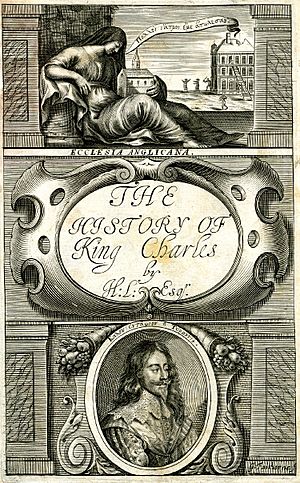Hamon L'Estrange facts for kids
Hamon L'Estrange (born 1605, died 1660) was an English writer. He wrote about history, religious ideas (theology), and church services (liturgy). He was a Calvinist, which is a type of Protestant belief. He was also very loyal to King Charles I and the Church of England.
Hamon L'Estrange helped bring back interest in old church service styles in the 1600s. He also started a new way of writing about the Book of Common Prayer, which is an important book for the Church of England. Sometimes, people get him mixed up with his father, son, or grandson, who all had the same name!
Contents
Life of Hamon L'Estrange
Early Years and Studies
Hamon L'Estrange was born in Sedgeford, Norfolk, England. He was baptized on August 29, 1605. He was the second son of Sir Hamon L'Estrange and his wife Alice Stubbe.
In 1617, he joined Gray's Inn, a place where people studied law. However, he spent most of his life studying religious topics. He held Calvinist beliefs, even when some church leaders at the time were cautious about Calvinism.
During the English Civil War
When the First English Civil War began, Hamon L'Estrange supported the King, just like other members of his family. He was called a "delinquent" for upsetting the Parliament's committee in Norfolk. This meant he was seen as someone who went against Parliament.
In August 1643, he was involved with his father and brother in a plan to give King's Lynn to the King's forces. Soon after, he became a colonel in the King's army. He mentioned that his property was taken away for about eight years, likely between 1643 and 1651.
By August 1644, he wrote that he had accepted Parliament's views. From 1651 onwards, he probably lived peacefully and comfortably in Ringstead, Norfolk and other places. He passed away on August 7, 1660, and was buried in Pakenham, Suffolk.
Important Writings
Hamon L'Estrange wrote several books. Here are some of his key works:
- God's Sabbath: This book, published in 1641, argued that the Sabbath (a day of rest and worship) was a rule from God that could not be changed. He dedicated it to both Parliament and his father.
- An Answer to the Marquis of Worcester's last Paper: In 1651, L'Estrange wrote this book. He responded to another writer, Thomas Bayly. L'Estrange argued against the idea that only the Catholic Church could decide what the Bible meant.
- Smectymnuo-mastix: Also published in 1651, this work defended the Church of England's prayer book (the Liturgy). He wrote it against a group called Smectymnuus, who had criticized the Liturgy.
- The Reign of King Charles: This history book about King Charles I was first published anonymously in 1655. A second, larger edition came out in 1656. This book was praised by other writers. It covered events up to the execution of Strafford. Another writer, Peter Heylyn, criticized this history.
- The Observator observed: L'Estrange wrote this in 1656 to reply to Heylyn's criticisms. Heylyn then wrote more replies, calling L'Estrange "stiffly principled in the Puritan tenets" and a "rigid sabbatarian." This meant Heylyn thought L'Estrange was very strict in his religious beliefs.
- The Alliance of Divine Office: This was Hamon L'Estrange's most important work. In it, he continued to discuss church services and practices, replying to Heylyn on these topics.
Family Life
Hamon L'Estrange had two well-known brothers: Sir Nicholas L'Estrange, 1st Baronet and Roger L'Estrange. His father also wrote a book that is sometimes mistakenly thought to be Hamon's.
Hamon L'Estrange was married twice. His first wife was Dorothy Laverick. His second wife was Judith Bagnall. He had five sons and five daughters. His oldest son, also named Hamon, passed away in 1717. This son married three times and had a large family. Sometimes, books written by Hamon L'Estrange's father have been wrongly given to his son.


